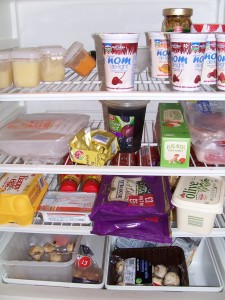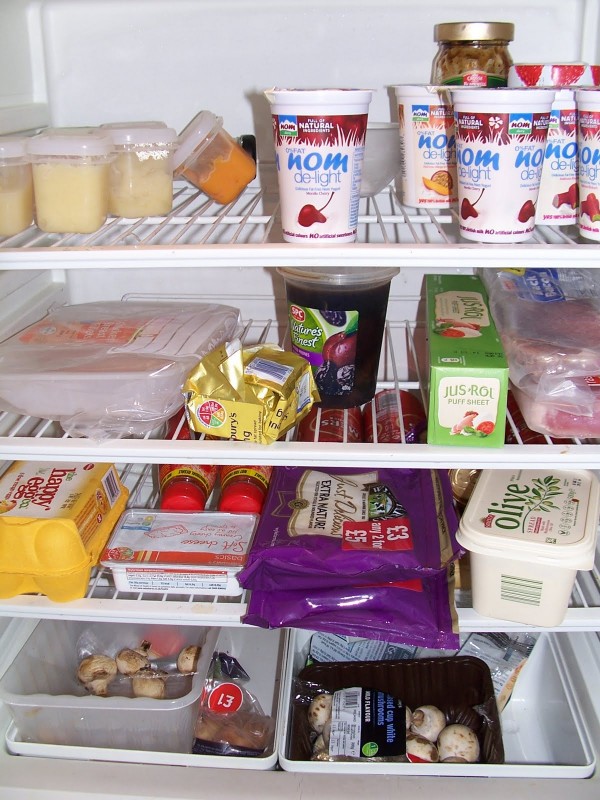 Most processed foods these days are unhealthy in one way or another. It is always best to eat food in its most natural state; fruits, vegetables, nuts, seeds, etcetera. Obviously, much of the world has adopted a different approach to food: processing and pre-packaging. While many items that you can buy at the store are okay in moderation, it is important for everyone who goes grocery shopping to be as educated as possible about what kinds of food are safe. Having a blacklist is a great idea, because some foods have no health benefit at all and are potentially harmful.
Most processed foods these days are unhealthy in one way or another. It is always best to eat food in its most natural state; fruits, vegetables, nuts, seeds, etcetera. Obviously, much of the world has adopted a different approach to food: processing and pre-packaging. While many items that you can buy at the store are okay in moderation, it is important for everyone who goes grocery shopping to be as educated as possible about what kinds of food are safe. Having a blacklist is a great idea, because some foods have no health benefit at all and are potentially harmful.
Let’s be honest, refrigerators are a fantastic invention, and most of us would be lost without them. However, some refrigerated foods are like automatic rifles pointed straight at your heart, or your stomach, or your thyroid. Eating highly processed foods on a daily basis means that related health problems are practically inevitable. Here are nine fridge foods that you should consider avoiding at all costs, and why they are considered so unhealthy.
1. Opened Canned Food
One major reason that canned food is controversial is because of BPA, a chemical that is found inside the lining of most canned foods. The lining comes into direct contact with the food inside the can, and this is problematic because BPA has been linked to serious side effects like heart disease and hormonal disorders. Canned foods also contain more sodium and preservatives than fresh and frozen foods do.
It is possible that once canned food is opened, harmful chemicals like BPA are more likely to be present in the food itself. Canned foods are also more thoroughly processed, and may lose nutritional value quickly once opened. If you must store food that came from a can, definitely transfer it to a different container first. In general, fresh and frozen foods are much better for our health, and will not contain such high levels of BPA.
2. Processed Meat
For processed meat, there are three main factors that are dangerous to your health: hormones, antibiotics, and preservatives. These meats are heavily processed and contain so many nonmeat ingredients that they are not worth eating. The hormones are intended to make the animal fatten up so that it yields more profit to the manufacturers, but hormones in meat have been linked to early puberty and other endocrine issues in people. Antibiotics are often pumped into livestock to prevent diseases, but when humans consume too many antibiotics, there can be catastrophic results on the body.
Gut health and immune system efficiency are the two most prominent side effects of antibiotic consumption. As for preservatives, they exist in most processed foods, but some kinds of preservatives have harmful effects on health. Salt is one of the most common, but the majority of people should actually be cutting down their overall salt intake. MSG is becoming more and more popular, but is linked to diseases like obesity and diabetes. There are ways that you can buy meat that help eliminate these risks, such as organic, hormone free, and antibiotic free.
3. Margarine
 Ah, margarine- butter’s evil twin. In essence, margarine is a synthetic, oil-based, inexpensive butter substitute. It sounds gross already, but wait, there’s more! Margarine is produced in the following way: first, vegetable oil is extracted using harsh chemicals like hexane. The oil is then held under high heat, destroying any potential nutrients.
Ah, margarine- butter’s evil twin. In essence, margarine is a synthetic, oil-based, inexpensive butter substitute. It sounds gross already, but wait, there’s more! Margarine is produced in the following way: first, vegetable oil is extracted using harsh chemicals like hexane. The oil is then held under high heat, destroying any potential nutrients.
The next step can be thought of as hardening the oils; what really happens is that a chemical process is used to turn most of the fat molecules into saturated and trans fats, which are the most harmful and unhealthy types.
Then, it is processed further, “purified,” and dyed yellow. Margarine exists to be a cheap alternative to butter, and nowhere in its development was human health taken into consideration. Vegetable oil by itself is not considered good for us, and has been linked to issues like heart disease. Margarine is an extensively processed product of vegetable oil, thus it has even worse effects on the body.
4. Old Leftovers
It seems that the general consensus about leftovers is that if you refrigerate the food within two hours, it is safe to eat for a few days afterwards. The main concern with leftovers is that bacteria can grow in and on the food, which can mess with your GI tract and make you sick. Technically, bacteria can begin to grow immediately on food, but the two-hour mark is when the bacteria really start to grow.
Most people agree that 3-4 days is the maximum amount of time that it’s safe to consume leftovers, assuming that they were put into the fridge promptly after being made, that the fridge is at a cold enough temperature, and that the food has not been removed from the fridge or reheated since it was made. Many people will only eat leftovers the next day, which is a good, cautious approach to take whenever possible.
5. Ketchup
An example list of ingredients for ketchup is: tomato concentrate, high fructose corn syrup, vinegar, corn syrup, salt, onion powder, spice, and natural flavors. Right off the bat, nothing on this list is particularly good for you, and three are potentially bad for you. The second ingredient is high fructose corn syrup, which is basically glucose and fructose- sugars. Frequent fructose consumption has been linked to serious side effects like high blood pressure, insulin issues, and heart disease.
Corn syrup, the fourth ingredient, is pure glucose. Excess sugars in the body often turn into fat and cholesterol molecules, both of which are things that most people don’t need extra of. The third ingredient on the negative side is salt; this isn’t because salt is inherently bad, but because of how much you consume with ketchup. 1 tablespoon of ketchup, according to the same nutritional label referenced above, contains 160mg of sodium. The bottom line with ketchup is that most people consume far more than 1 tablespoon, and the salt level adds up fast.
6. Salad Dressings
Some salad dressings are far worse than others. Vinaigrettes tend to be the best, while creamy dressings tend to be the worst. However, it all depends on the specific dressing, because many types of vinaigrette contain tons of sugar and salt. High fructose corn syrup is often put into these dressings to help boost their flavor, but this ingredient can have detrimental health effects. Ranch is arguably the most popular dressing type, and unfortunately, it is one of the unhealthiest.
Ranch contains MSG, a flavor booster and preservative that is thought to contribute to obesity and diabetes. Ranch also contains hydrogenated oils, which cause awful damage to blood vessels, lead to high cholesterol, and more. Needless to say, this particular salad dressing is high in fat and salt, as well. If you need salad dressing in your life, then being picky is a good thing; or, better yet, make your own dressings!
7. Processed Cheese
American cheese is one of the most popular processed cheeses. The term “processed cheese” defines products that are made from real cheese, but have other ingredients added to them, such as whey, emulsifiers, milk, artificial coloring, salt, et cetera. Emulsifiers are artificial additives that are used in the manufacturing process.
A common example is sodium phosphate, which has been linked to kidney problems. Artificial colors are more common in artificial cheeses; yellow 6 is used in American cheese, and has been linked to kidney and hormone related problems. Cheeses in this category often contain fillers like dairy substitutes, which reduce the quality of the product.
8. Mayonnaise
 One tablespoon of mayonnaise has around 10 grams of fat, 1.5 of which is saturated fat, 90 calories, and 100mg of sodium. This condiment is basically vegetable oil, egg yolk, and vinegar, in that order, plus flavorings and preservatives. Like ketchup, mayo is usually consumed in higher quantities than 1 tablespoon, and so the fat and salt content add up.
One tablespoon of mayonnaise has around 10 grams of fat, 1.5 of which is saturated fat, 90 calories, and 100mg of sodium. This condiment is basically vegetable oil, egg yolk, and vinegar, in that order, plus flavorings and preservatives. Like ketchup, mayo is usually consumed in higher quantities than 1 tablespoon, and so the fat and salt content add up.
Store bought mayo is usually very high in fat and sodium, and the additives like preservatives don’t help its case. Some types of mayonnaise are made with soybean oil, which means that the product contains estrogen. Frequent consumption of soy can lead to hormone problems in the body due to its estrogen content. Because mayo packs so many calories and so much fat into such a tiny serving size, people who eat it regularly may have a hard time reducing body fat or lowering blood pressure.
9. Fruit Juice
Store bought fruit juice usually isn’t actually fruit juice. It is most commonly juice concentrate combined with sugar, sugar, preservatives, and more sugar. Quite a few scientific researchers have determined that commercial fruit juice is probably almost as bad as soda. While fruit juice may have some substance to it from the fruit that the concentrate was made of, it contains so much sugar that it may as well be looked down upon as much as soda. Regular consumption of drinks that are high in sugar can lead to obesity, diabetes, high blood pressure, and heart disease, among others. This conclusion also applies to most pre-made fruit smoothies. The healthy factor in fruit juices simply does not make up for the extreme sugar levels.
Obviously, processed foods tend to be bad for us. If you consider this list, there are some general rules that can be drawn from it.
It’s best to avoid items with high fructose corn syrup, items with MSG, items with sugar listed multiple times in the ingredients list in different forms, items that pack salt and calories into a tiny serving size, items with artificial colorings, and items high in saturated or trans fats.
You don’t have to become a foods expert to shop smart at the grocery store, but you do have to understand some general ideas about human health. Too much of anything is a disaster waiting to happen; when it comes to store bought food, this is especially true for salt and sugar. Some seemingly healthy foods are heart attacks waiting to happen, such as fruit juice.
Figuring out that fruit juice may actually be bad because of its sugar level requires that you read the nutrition label. Nutritional labels and ingredients lists can be your best friends!
If you are eating these foods frequently, your digestive system might be weakened. Go to the next page and watch the 3 digestive tips for a strong gut and digestive system.
About the Author:
Emma Deangela is the best selling author of The Alkaline Diet Program and 80/20 Fat Loss. She has helped over tens of thousands of men and women to lose weight and transform their health with sound nutrition advice.
What other foods in your fridge do you think it’s bad for your health? Share with us in the comments below.
Please help us to share this eye-opening article with your friends using any of the social media and email buttons below.


Leave a Reply